
For over six months, the Young, Gifted and Black Coalition (YGB) has been at the forefront of a movement on the move in Madison, Wisconsin, and Z! Haukeness, a white racial justice leader who has worked in both majority Black and majority white efforts over the past decade, has been at the heart of it.
The organizing in Madison is both expansive and deep, drawing from new leadership, along with lessons and relationships forged out of past organizing, including the mass economic justice occupation of the capitol in 2011, which precipitated the Occupy Wall Street movement.
In these times of Black Lives Matter movement, tens of thousands of white people are coming into consciousness about institutional racism and grassroots racial justice activism. Many are getting involved in their communities and are trying to navigate the nuances and challenges of working, as white people, against, what bell hooks calls, white supremacist capitalist patriarchy. Z! Haukeness has been a leader in white anti-racist organizing for years, and it’s important for white people reading this, who are newer to the work, to know that Z! started off new to the work too, and came up through an organization called the Groundwork Collective, went through the Anne Braden Anti-Racist Organizer Training Program run by the Bay Area-based Catalyst Project, and, as Z! mentions throughout the interview, their work is the result of getting involved, sticking around, learning from the people you’re working with, and being part of organizations and campaigns over the long haul.
Groundwork in Madison was cofounded by white racial justice leader Laura McNeill, who had been active in the global justice movement following the Seattle 1999 mass direct actions and the post-Sept 11 anti-war movement. Laura and I were both members of the white anti-racist Bay Area-based Heads Up Collective, which formed after Sept. 11 to help unite the majority white, direct action-oriented, anti-war movement with the people of color-led, economic and racial justice movement fighting the war at home and abroad.
As Laura pre-prepared to move to Madison, I remember a Heads Up meeting devoted to helping her think through starting up a similar-style group there. Z! and many other white racial justice leaders in Wisconsin came up through the group Laura helped start. I share this story to highlight the way this work is deeply relational and collective and that experienced people’s leadership in this time is needed to help create infrastructure that new people can be part of; and to encourage new people to look for opportunities to get involved in on-going local efforts; and to look for mentorship and support from those who have been around for a while. From the outside, movements can seem mysterious and overwhelming; it’s important to help demystify them and encourage people to find their path into the work.
This is the fifth interview in a series with white racial justice organizers and leaders from around the country, to draw out examples of what white activists are doing and can do, along with insights and lessons born from years of experience. My goal is to help equip white people to be courageous, humble, visionary, accountable, loving and effective as we, as white people, work to save white communities from the death culture of white supremacy and unite our people with the deeply life-affirming, liberatory power of the Black Lives Matter movement. While white people need to be mindful of how white privilege operates, we must also be powerful for collective liberation, knowing that the time for us to rise against structural racism is now.
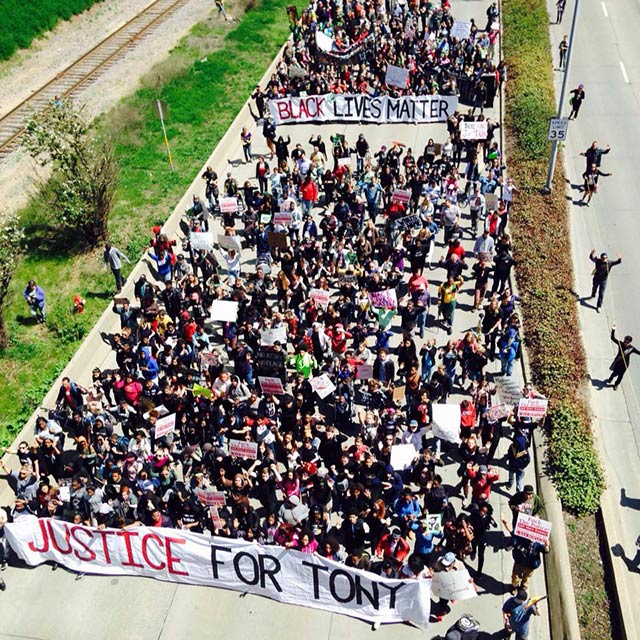 Blackout Wednesday rally following the non-indictment of Matt Kenny who killed Tony Robinson. (Photo: Z! Haukeness)
Blackout Wednesday rally following the non-indictment of Matt Kenny who killed Tony Robinson. (Photo: Z! Haukeness)
Chris Crass: How are you working to move white people into racial justice movement in this time? What’s working? And what are you learning from what works?
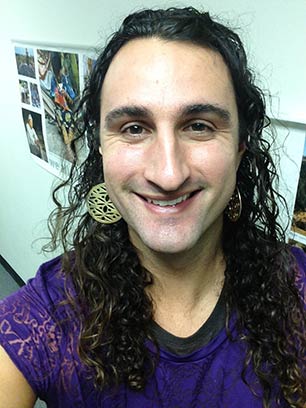 Activist Z! Haukeness. (Photo: Z! Haukeness)Z!: My main work to move white people into racial justice work in this time has been through working closely with a Black organization called Young Gifted and Black Coalition (YGB), which formed in response to the non-indictment of Darren Wilson and killing of Michael Brown.
Activist Z! Haukeness. (Photo: Z! Haukeness)Z!: My main work to move white people into racial justice work in this time has been through working closely with a Black organization called Young Gifted and Black Coalition (YGB), which formed in response to the non-indictment of Darren Wilson and killing of Michael Brown.
My white racial justice roots are with Groundwork, a collective of white people working for racial justice that has been around for the past 10 years in Madison, Wisconsin. I have also worked closely with a few other organizations, including the No New Jail Group, a multi-racial abolitionist group that formed to challenge a county-initiated proposal to build a new jail in Madison; MOSES, a predominately white faith-based organization working to oppose the jail, and with the Wisconsin Network for Peace and Justice, a statewide, primarily white, organization working on a variety of social justice, sustainability and peace issues around Wisconsin.
YGB is a mostly queer, women- and trans-centered group dedicated to ending state violence against Black people through direct action. YGB has centered the myriad ways that state violence affects Black people and has linked police killings with a fight to stop the building of a new jail in Dane county. State violence in Madison and Dane County is most visible through mass incarceration and vast racial disparities in the local aspects of the prison industrial complex, some of the worst in the country.
YGB has held weekly actions since November to push for four main demands related to the jail and mass incarceration of Black people. Both the demands and the actions have given a framework for white people to plug into and take roles to achieving a local strategy that has been largely mapped out by YGB.
There has been an incredible multi-racial movement to break down jail walls and pierce liberal racism, while giving a vision of hope and possibility for true liberation. The leadership and engagement of young Black people and other people of color has been central, and the work of white people has also been key. YGB, other people of color and white people have all done work to educate and engage white people in the moment.
“We are seeing record-breaking numbers of people participating: white and people of color. More and more people are finding ways to take action.”
Examples of the work that white people and other allies have done to build up and support the work of YGB include showing up over and over at weekly actions that include shutting down traffic, die-ins, community forums and blocking the doors of the jail for hours. Hosting widely attended debates and a speaker series at the University to educate, build connections and give credibility to YGB’s work. Holding a weekly series of living room conversations and fundraisers for eight weeks at various homes to discuss YGB’s work and educate about white people and people of color who are not Black taking action. Forming groups like Asians For Black Lives, and a budding Latin@s for Black Lives. Starting a queer racial justice fund to support queer Black organizing. Organizing statewide conference calls bringing together urban and rural, Black organizers and white farmers. Writing statements, Op-Eds and letters to the editor from individuals and organizations to explain racism, white privilege and the key parts of the demands for justice locally. Planning actions independently from, and in accountability with, YGB. Parent groups planning actions for children to be involved in. Holding community forums to educate on the role for allies in the local movement.
The list goes on and on. It is challenging to write a limited summary because the depth of work and involvement has been so vast on many fronts. Black people, white people and other people of color have been truly shifting the structures and systems that perpetuate state violence against Black people.
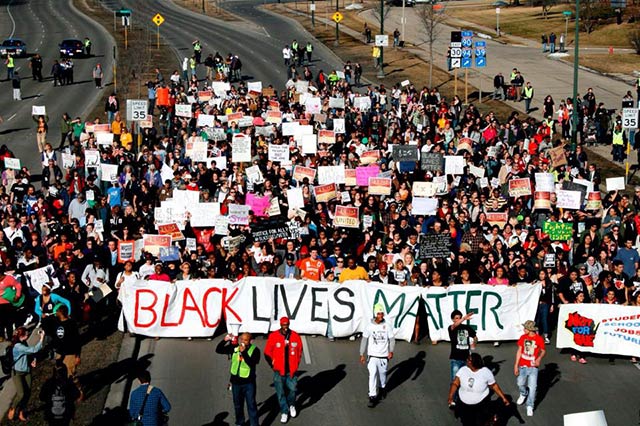 We Rise! Rally in Madison for Justice for Tony Robinson, no cuts to Wisconsin education, $15 an hour minimum wag, and an end to mass incarceration, in collaboration with Milwaukee folks. (Photo: Leslie Amsterdam)
We Rise! Rally in Madison for Justice for Tony Robinson, no cuts to Wisconsin education, $15 an hour minimum wag, and an end to mass incarceration, in collaboration with Milwaukee folks. (Photo: Leslie Amsterdam)
How do you think about effectiveness and how do you measure it? Can you share an experience that helps you think about effective work in white communities for racial justice?
The work of YGB has been covered by all major and alternative news sources consistently for 6 months. Everyone in Madison has heard about YGB and Black Lives Matter (BLM) and have had to decide what their position is on the killing of unarmed Black people by the police and the gross racial disparities of policing and the prison industrial complex.
At rallies, die-ins, public testimony, community forums and the conference calls, we are seeing record-breaking numbers of people participating: white and people of color. More and more people are finding ways to take action and to further commit to the struggle for Black lives and racial justice.
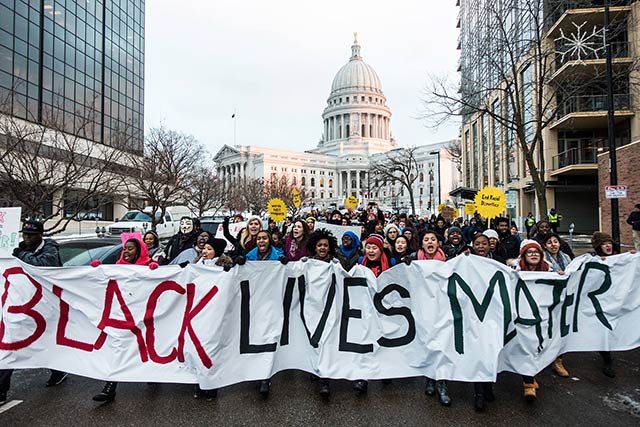 First YGB rally the day after Darren Wilson’s non-indictment, marching from the jail to testify at the county board hearing on jail funding. (Photo: Nate Royko Maurer)
First YGB rally the day after Darren Wilson’s non-indictment, marching from the jail to testify at the county board hearing on jail funding. (Photo: Nate Royko Maurer)
A concrete success came with the passage of a resolution at the county level, which hundreds of people testified on at committee meeting after committee meeting, for months. The work outlined in the resolution stops the county from building a new jail, moves towards ending solitary confinement, creates alternatives to incarceration, and seeks to end racial disparities in the criminal system. It is beautiful to see its passage as a result of a popular movement rooted in direct action, political engagement and base-building.
Many of the white people that I see showing up regularly to testify or put their bodies on the line, have been involved in Groundwork in some way over the past 10 years. Either they have taken a workshop or have been more closely involved in the organization. Similarly, the base-building and educational work of groups of color like Freedom Inc. have helped bring a base of leadership and analysis to the current movement moment. Multiple new organizations have grown, contributed and strengthened over this time period as well.
Personal stories of transformation are another way of measuring the effectiveness of the movement. For example, my family members are increasingly supportive. My mom talks more and more passionately about the need for change; my mom’s husband, who lives in the countryside of rural Wisconsin, texted me about how much he supports the Baltimore Uprising and how the media is getting it all wrong; a friend is getting deeply engaged after being on the sidelines, unsure of how to get involved for years; and broad education is taking place in various organizations around the BLM movement, mass incarceration and abolitionist politics.
A show of effectiveness is that this movement moment has sustained at a high level for six months, and I believe deeper, thicker roots are currently forming.
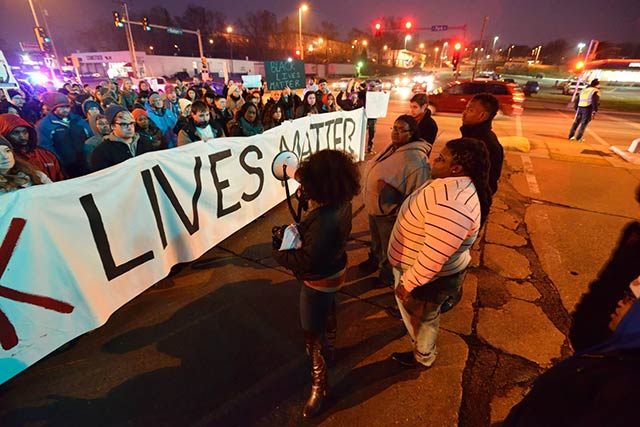 Rally on Park Street blocking traffic for four minutes in honor of Mike Brown. (Photo: Nate Royko Maurer)
Rally on Park Street blocking traffic for four minutes in honor of Mike Brown. (Photo: Nate Royko Maurer)
What are the goals and strategies (as emergent, planned, messy and sophisticated, basic as it is) you’re operating from?
My goals for engaging white people who are waking up to racism and police violence, or getting more deeply committed to racial justice, is to help move them, in whatever way they can, to participate towards achieving Black liberation, Black power, Black queer power, Black trans power, Black migrant power, Black disability power, Black cis-women’s power, Black cis-men’s power, and to end violence against Black people. Both YGB and BLM have an incredible intersectional analysis to help guide this work forward.
YGB Demands
As stated above, YGB’s vision has been the guiding light for this movement moment locally. This includes their demands, but also their approach of direct confrontation of power structures and pushing people to a new understanding of white supremacy and the immediate need for change.
The demands around the jail are: 1) no new jail or major renovations to the current jail; 2) release 350 Black people incarcerated due to racial and economic oppression; 3) end solitary confinement; and 4) divert money that would be spent on incarceration to Black-led alternatives and community-based solutions to addressing racial disparities.
Since Tony Robinson was killed and the police officer who killed him was not charged, making National headlines, the group has added two demands: 1) The United Nations must do a truly independent investigation into the murder of Tony Robinson and the gross racial disparities of Dane County; and 2) there must be true community control over the police to make decisions on policies, practices, procedures, hiring and firing.
 Blackout Wednesday action following the decision not to indict Matt Kenny in the killing of Tony Robinson. Groundwork, Discord Collective and Asians for Black Lives blocked the doors of the Dane County Jail for 3 hours and 50 minutes. (Photo: Jesse Cole)
Blackout Wednesday action following the decision not to indict Matt Kenny in the killing of Tony Robinson. Groundwork, Discord Collective and Asians for Black Lives blocked the doors of the Dane County Jail for 3 hours and 50 minutes. (Photo: Jesse Cole)
Black Lives Matter (BLM) Framework
YGB, myself and others have also followed the BLM framework and worked to honor the leadership and history of the movement. We were able to bring Opal Tometi, one of the cofounders of BLM to Madison to speak to a few hundred people about the movement and keep the BLM framework central to our local work.
We have always told the story of Alicia Garza creating the hashtag and partnering with Patrisse Cullors and Opal to create the organization, highlighting the importance that this was created by two queer women and the daughter of Nigerian immigrants. We have worked hard and learned from their framing that centers state violence against all Black lives, particularly highlighting those whose deaths are often forgotten, such as Black cisgender and trans women.
White Anti-Racist Basics
I have also been operating under principals that I have learned over the years through white racial justice organizing and from mentors and educators. Some of the principals include: Show up, listen, support; engage in activity rather than critiquing from the sidelines; get out front and be loud for racial justice when the time is right, stay in the background when the time is right; educate other white people about racism so it doesn’t all fall on people of color; do personal education and skill building; engage more white people in action; find ways for white people to bring their full leadership to the fore in respectful ways; and recruit resources including financial support to the movement.
Building an Anti-Racist White Majority
There is great potential right now to move white people to consciousness around white supremacy. We have a chance to really shift the scales and create long-lasting structure and momentum to continue engaging large numbers of white people to work for racial justice in an accountable way. We still have a long way to go, but we are making moves.
What challenges are you facing? How are you trying to overcome them? What are you learning from these experiences?
Over the years I have often walked the line of working with predominately people of color organizations, while also working in predominately white organizations with a focus on racial justice. Most of my work in this moment has been working closely with people of color, while much of my role has been to engage white people and move a strategy forward in a predominately white community with white power holders.
“I felt I was only doing enough for racial justice if I physically and emotionally couldn’t get out of bed because I was too worn out.”
While this isn’t a universal role for white people to play, it has been a natural role for me due to years of personal and organizational relationship building. My relationships with others in YGB have come largely from my relationships with Groundwork, Freedom Inc., Operation Welcome Home, and other local groups as well as personal relationships. For many years, I have learned from mentors, showed up, made mistakes, built relationships, struggled through relationships, taken action, made great strides, fell down with shame and grief and confusion and got back up to repeat the cycle. I have done this in community and the importance of organization shines through in this process.
While the work of maintaining multi-racial connections and relationships in organizing is crucial work, it is important that white people work with other white people and sometimes that means having little direct contact with people of color in leadership.
Also in this time of an amazing flow of energy, a window has opened in this movement moment, which also calls on a huge flow of time and energy put in by organizers. Myself and others have put in hours and hours of volunteer time and have had trouble balancing this work responsibility with our other work and life responsibilities. For many years of doing work as an “ally” I have pushed myself to work and work until exhaustion and burn out. I felt I was only doing enough for racial justice if I physically and emotionally couldn’t get out of bed because I was too worn out. Then I was doing enough. I have moved along that path to now see my own health and well-being as necessary to my effectiveness in being a leader for racial justice. I am working to practice and cultivate resiliency, and while there are still ups and downs, and periods of burn-out due to the high intensity of the work, I have found better balance and have limited the depth of the low points.
Another challenge I have been facing is related to “calling white people in” rather than calling them “out” while showing anger and rage for the system that many white people in power are upholding. Groups similar to Groundwork across the country often use the principal of calling white people in and building with love; however, it has been important to directly challenge the racism of the police chief and others in power. While these politicians and public officials may be well intentioned, as representatives and enforcers of systems that are inflicting state violence and killing Black people, they need to be challenged publicly.
“We are loving each other and growing with each other. We are having conflict with each other and challenging each other to grow. We are teaching one another and getting on each other’s nerves.”
Similarly, I have struggled with the fine line of calling white people in, while directly challenging those who say they are for justice, but consider YGB too radical or “violent.” The Midwestern and liberal niceties and a broad thinking that Madison is progressive, have gotten us to where we are with drastic racial disparities. It has been a lesson that calling in isn’t always nice, and without conflict, and has pushed my own aversion to direct conflict. Having white people show anger and frustration, as well as love and compassion, participate in controversial actions, and really challenge white people to get uncomfortable and understand the need for more direct tactics and conversations have helped to dissipate this dilemma.
We need both. We need to directly challenge those who are upholding the system, and create spaces and opportunities to bring in those willing to get educated to fight against it.
How are you developing your own leadership and the leadership of people around you to step up in these profound, painful and powerful Black Lives Matter movement time?
The energy, momentum and community that has been built and strengthened over the past 6 months thrives on natural and organized opportunities for leadership development.
The community forums, teach-ins on legislation, debates between YGB and the sheriff, nationally recognized speakers, core group and base education, one-on-ones, door knocking are all ways that YGB, Groundwork, and various organizations have been engaging in leadership development and political education.
However, possibly the most powerful has been the shared work together. When we spend long hours in strategy meetings in various organizations, when we greet one another at events, when we strategize over dinner, when we laugh and joke over drinks, when we check in at rallies and actions, when we wait through long hours of testimony or deliberation at County Board committee meetings, and when we have long one-on-one conversations about how we are struggling personally or organizationally and how to move through it together.
We are loving each other and growing with each other. We are having conflict with each other and challenging each other to grow. We are teaching one another and getting on each other’s nerves. We are doing our own work and we are bringing in new people, we are building a movement, we are making waves, working hard to plant roots, and growing beautiful change.
I’m always learning by doing, learning by reflecting, learning by listening to those around me, reading books, watching Youtube videos. I’m learning by making mistakes, by having some new triumphs, by pushing myself, hard, and by being gentle with myself. I’m reaching out to community, and I’m taking care of those I love around me who are giving so much.
We have been developing new leadership by creating avenues for people to get engaged, to learn, to take action, to love, to hurt, and to fan the flames of change; to be part of the life-or-death movement to make Black Lives Matter.
Z! Haukeness is a community organizer in Madison, Wisconsin, working on various racial and social justice issues locally and nationally. Z! is trans and gender nonconforming and carries the privilege and oppression of this identity in their work for liberation. Thanks to Sara McKinnon, Karma Chávez and Laura McNeil for their help editing.
Media that fights fascism
Truthout is funded almost entirely by readers — that’s why we can speak truth to power and cut against the mainstream narrative. But independent journalists at Truthout face mounting political repression under Trump.
We rely on your support to survive McCarthyist censorship. Please make a tax-deductible one-time or monthly donation.